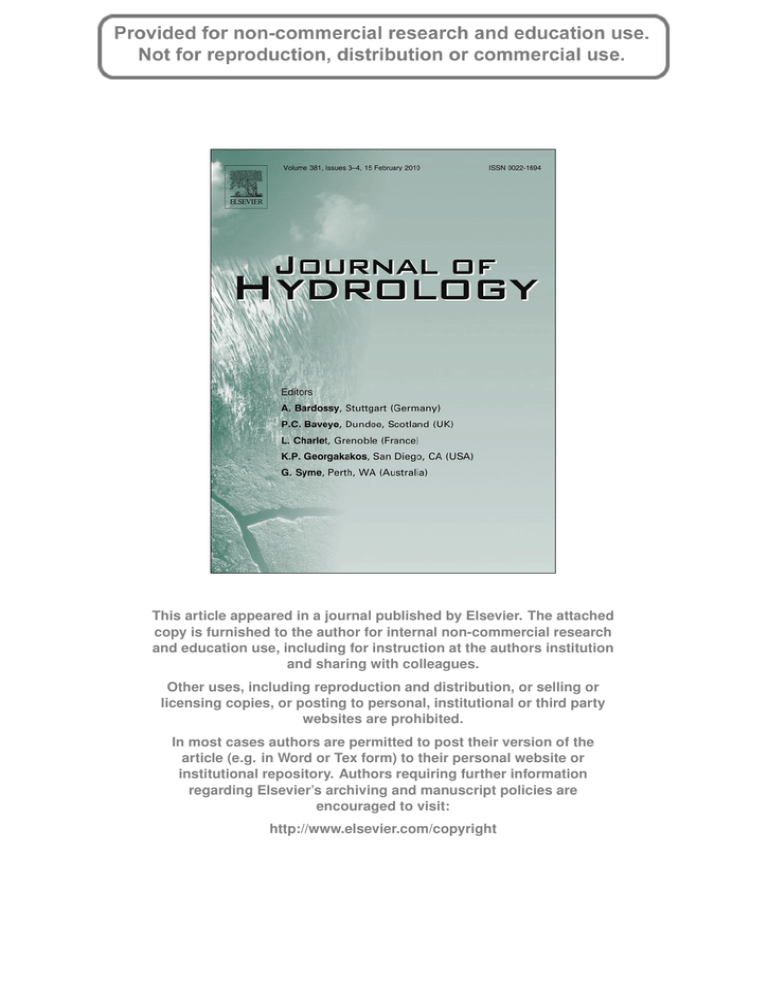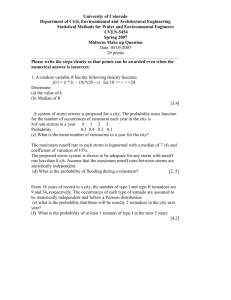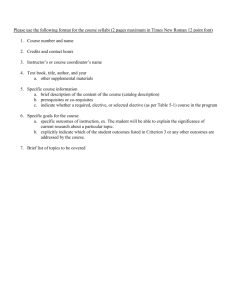
This article appeared in a journal published by Elsevier. The attached
copy is furnished to the author for internal non-commercial research
and education use, including for instruction at the authors institution
and sharing with colleagues.
Other uses, including reproduction and distribution, or selling or
licensing copies, or posting to personal, institutional or third party
websites are prohibited.
In most cases authors are permitted to post their version of the
article (e.g. in Word or Tex form) to their personal website or
institutional repository. Authors requiring further information
regarding Elsevier’s archiving and manuscript policies are
encouraged to visit:
http://www.elsevier.com/copyright
Author's personal copy
Journal of Hydrology 381 (2010) 374–376
Contents lists available at ScienceDirect
Journal of Hydrology
journal homepage: www.elsevier.com/locate/jhydrol
Reply to comment on ‘‘Development and testing of a new storm
runoff routing approach based on time variant spatially distributed travel time method” by Du et al. [Journal of Hydrology 369
(2009) 44–54]
We enjoyed the comments and discussion provided by Saghafian and Noroozpour and appreciate their interest in our work and
their careful reading of our paper. We also acknowledge their
introduction of references that were overlooked by us. Our response below follows the order of their comments.
1. The aim of the paper was to propose a distributed storm runoff
routing approach that should not only retain the physical basis
but also produce acceptable results for operational use and
application. Fully physically based models suffer from, among
others, the difficulty of large data requirements and the need
to estimate parameter values which not only give good results
but are also physically reasonable. The main idea of the
approach is that a single raster data structure is established
for the whole computation process whereas the rainfall process
is divided into several time intervals, and for each time interval
the following procedure holds: (1) The excess rainfall intensity
is computed using the SCS method for each cell (grid or pixel);
(2) The accumulated runoff for each cell is estimated using the
GIS flow accumulation function; (3) The travel time for each
overland flow cell is estimated using Eq. (8); (4) The travel time
for each channel cell is estimated using Eq. (20); (5) The travel
time to outlet (cumulative travel time) for each cell is calculated using the GIS flow length function; and (6) The runoff
hydrograph at the watershed outlet contributed by the excess
rainfall over this time interval for all cells is computed (the runoff at each respective arrival time being determined by the sum
of the volumetric flow rates with the same arrival time from all
contributing cells). When all runoff hydrographs for any time
interval have been calculated, the final runoff hydrograph can
be estimated easily.
One of the key aspects is the travel time estimation. There are
many methods to calculate travel time for overland and channel
flow including theoretical equations described in text books (e.g.
Singh, 1988) and different variants of simplifications used in
hydrological modelling, such as the method based on the concept
of time to equilibrium (Chow et al., 1988; Saghafian and Julien,
1995), the method of assigning a velocity as a function of distance
from the channel and the outlet (Calver, 1993), the formula presented in the National Engineering Handbook of the US Soil Conservation Service for overland flow velocity as a function of land
surface slope, the method in which local velocity in each cell can
be estimated by modifying the mean velocity for the watershed
by a function of the local slope and the upstream drainage area
0022-1694/$ - see front matter Ó 2009 Elsevier B.V. All rights reserved.
doi:10.1016/j.jhydrol.2009.10.041
(Maidment et al., 1996), the method assuming that travel time
for each cell in a watershed is simply proportional to the time of
concentration (Kull and Feldman, 1998), the method based on
the average velocity, the maximum velocity, and average wave
celerity for a constant upstream inflow and a uniform net rainfall
intensity input (Wang, 2003), and a newly developed aggregated
network-response-function (NRF) routing algorithm (Gong et al.,
2009), etc.
In our approach, the overland flow travel time in a grid cell was
estimated by combining a steady state kinematic wave approximation with Manning’s equation, and the channel flow velocity was
estimated using Manning’s equation and the steady state continuity equation for a wide channel. An amendment was made to channel flow velocity by approximating Manning’s equation to remove
river width from the original formula which is difficult to estimate.
The reason we selected such a method, even though it has some
limitations as in many other operational models, was to develop
a distributed storm runoff routing approach that should not only
retain its physical basis but also produce acceptable results for
operational use and wide application. Simple to use and still having
a physical basis, this concept has been applied in some research
works with good results (Muzik, 1996; Melesse and Graham, 2004).
2. The K parameter introduced in Eq. (19) accounts not only for
some estimation error in the Manning roughness coefficient
(n) and the bed slope but also for the simplification error in
deriving the velocity formula (with the kinematic wave
approximation, the wide channel assumption, and Manning’s equation approximation for removing river width
from the original formula). Therefore, a calibrated value of
7.5 for K does not necessarily mean that the channel roughness is under-estimated by a factor of 7.5. The advantage of
introducing K to the equation is: (1) it accounts for some
error in parameter estimation, such as Manning roughness,
river bed slope and overland slope; (2) it compensates for
the error in deriving the model structure, such as that arising
from the steady state kinematic wave approximation which
is a case that seldom happens for storms in natural watersheds; all models being simplifications of nature. Thus, the
usefulness of introducing the K parameter (even though
it’s physical meaning is less clear than that of the other
parameters) is threefold: (1) it facilitates good agreement
between the simulated results and the observed ones, (2)
it simplifies the calibration process by reducing the number
of parameters requiring calibration, and (3) more importantly, it prevents the calibrated values of other parameters
from going beyond the scope of reasonable values, i.e. it
keeps the magnitudes of the other parameter values within
their theoretically feasible range.
3. In our model, the ‘excess rainfall intensity times the grid cell
squared’ was calculated as the total input for each overland
Author's personal copy
Correspondence / Journal of Hydrology 381 (2010) 374–376
4.
5.
6.
7.
8.
9.
cell. Only in computing the travel time (Eq. (8)) the distance
l was set equal to the grid size multiplied by 1.41 for an
overland cell having flow in the diagonal direction. Thus,
mass balance is maintained.
For the steady state kinematic wave approximation in this
small mountain watershed, the flow velocity at each overland cell was considered to be independent of the upslope
cell inflow. The effect of flow accumulation in overland cells
was not considered. In channel river flow, the effect of flow
accumulation was considered for each time interval. The
excess rainfall intensity was calculated for every cell, the
cumulative inflow for all cells (overland and channel cells)
was carried out by using the GIS flow accumulation function
which is amenable for the discharge and flow calculation
equations.
Q represents the cumulative runoff at time step t, the runoff
at the time step being the difference between cumulative
runoff at time step t and that at time step t 1 as is shown
in Eq. (23) of Du et al. (2009).
The calibration process was performed as follows: five
cells were selected as the first channel threshold, then
10 cells as the second; 1, 50 and 100 were selected based
on an analysis of the results of the first two calculations to
establish the tendency. The value 5 was determined to be
the channel threshold by calibration on the basis of multiobjective analysis results. We think this is reasonable for
this small watershed located in a mountain region where
channel flow is a dominating phenomenon and that it is
not appropriate to compare this with values found in the
literature because the calculation methods used and
topography of the watersheds are different.
The surface runoff routing was not considered in the way
Saghafian and Noroozpour appear to have assumed. If done
in that way, the travel time based runoff routing would be
overly complicated for an operational model calculation
and a full physically based distributed model may be more
suitable than using the travel time based method. Therefore,
in our model, the excess rainfall at each cell for every time
interval was routed to the watershed outlet separately, in
accordance with the procedure described above.
We calibrated the first storm (which happened to be the
earliest), and validated the model using the other storms.
As the results were satisfactory, we did not make any
amendments to them. The SCS curve number procedure
was developed at the watershed scale to calculate the
streamflow from a storm (total storm volume minus baseflow). A storm usually occurs in fits and starts and is hardly
continuous. It has never been established (to our knowledge) that the storm has to be a continuous process.
Saghafian and Noroozpour have raised an important and
interesting issue; however, we do not share their opinion
that the SCS is unable to deal with the saturation excess
phenomenon. Such an opinion is a misinterpretation of
what runoff from curve number procedure is. In this context, the authors refer to the excellent paper of Garen and
Moore (2005), where details of the SCS method, i.e. its concept, procedure, uses and abuses, are discussed. It is a common misunderstanding that SCS can only be used to
calculate infiltration excess runoff. According to USDA-SCS
(1972), the curve number procedure was designed to predict direct (surface) runoff which is composed of streamflow
arising from different mechanisms in unknown proportions
and where it is unknown whether this flow is generated
from all or part of the land area of the watershed. Garen
and Moore (2005) also noted that Victor Mochus, the developer of the curve number method, expressed the view that
375
saturation overland flow was the most likely runoff mechanism to be simulated by the method and not necessarily
Hortonian overland flow or crusting. Other researches have
shown that the basis of the SCS method can be described in
ways that are nominally consistent with both the infiltration-excess concept (Hjelmfelt, 1980) and saturation-excess
hydrology (Steenhuis et al., 1995). In its most elementary
form, the traditional SCS-CN method is conceptually consistent with the saturation-excess hydrology (Lyon et al.,
2004).
10. We claimed it as a new storm runoff approach because our
procedure (or framework) for routing runoff is different
from SDDH, which holds the travel time field to be static,
and it also differs from other time-area based methods
which need to establish the unit hydrograph or isochrones
(even time variant isochrones such as proposed by Saghafian et al. (2002)). With our method, once the cumulative travel time for all cells has been computed, the discharge
process at the outlet can be generated without relying on
the unit hydrograph or isochrones. What is deserving of further study, however, is to apply different travel time computation methods to our studied watershed and to
compare the results.
Acknowledgment
The authors would like to express their sincerely thanks to Prof
V.P. Singh of Texas A&M University for proofreading our reply.
References
Calver, A., 1993. The time-area runoff formulation revisited. Proceedings of the
Institution of Civil Engineers: Water, Maritime and Energy 101, 31–36.
Chow, V.T., Maidment, D.R., Mays, L.W., 1988. Applied Hydrology. McGraw-Hill Inc.,
New York, USA.
Du, J.K., Xie, H., Hu, Y.J., Xu, Y.P., Xu, C.-Y., 2009. Development and testing of a new
storm runoff routing approach based on time variant spatially distributed travel
time method. Journal of Hydrology 369, 44–54.
Garen, D.C., Moore, D.S., 2005. Curve number hydrology in water quality modeling:
uses, abuses, and future directions. Journal of American Water Resources
Association 41 (2), 377–388.
Gong, L., Widén-Nilsson, E., Halldin, S., Xu, C.-Y., 2009. Large-scale runoff routing
with an aggregated network-response function. Journal of Hydrology 368, 237–
250.
Hjelmfelt, A.T., 1980. Curve number procedure as an infiltration method. Journal of
the Hydrology Division, American Society Civil Engineers HY6, 1107–1111.
Kull, D.W., Feldman, A.D., 1998. Evolution of Clark’s unit graph method to spatially
distributed runoff. Journal of Hydraulic Engineering – ASCE 3 (1), 9–19.
Lyon, S.W., Walter, M.T., Gérard-Marchant, P., Steenhuis, T.S., 2004. Using a
topographic index to distribute variable source area runoff predicted with the
SCS curve-number equation. Hydrologic Processes 18, 2757–2771.
Maidment, D.R., Olivera, F., Calver, A., Eatherall, A., Fraczek, W., 1996. Unit
hydrograph derived from a spatially distributed velocity field. Hydrologic
Processes 10, 831–844.
Melesse, A.M., Graham, W.D., 2004. Storm runoff prediction based on a spatially
distributed travel time method utilizing remote sensing and GIS. Journal of the
American Water Resources Association 40 (4), 863–879.
Muzik, I., 1996. Flood modeling with GIS-derived distributed unit hydrographs.
Hydrologic Processes 10, 1401–1409.
Saghafian, B., Julien, P.Y., 1995. Time to equilibrium for spatially variable
watersheds. Journal of Hydrology 172, 231–245.
Saghafian, B., Julien, P.Y., Rajaie, H., 2002. Runoff hydrograph simulation based on
time variable isochrone technique. Journal of Hydrology 261, 193–203.
Singh, V.P., 1988. Hydrologic Systems. Rainfall-Runoff Modeling, vol. 1. PrenticeHall, 138 Inc., Englewood Cliffs, NJ.
Steenhuis, T.S., Winchell, M., Rossing, J., Zollweg, J.A., Walter, M.F., 1995. SCS
runoff equation revisited for variable-source runoff areas. American Society of
Civil Engineers, Journal of Irrigation and Drainage Engineering 121, 234–
238.
USDA-SCS (US Department of Agriculture-Soil Conservation Service), 1972. SCS
National Engineering Handbook, Section 4, Hydrology. Chapter 10, Estimation
Author's personal copy
376
Correspondence / Journal of Hydrology 381 (2010) 374–376
of Direct Runoff from Storm Rainfall. US Department of Agriculture, Soil
Conservation Service, Washington, DC, pp. 10.1–10.24.
Wang, T.S.W., 2003. Comparison of celerity-based with velocity-based time of
concentration of overland plane and time of travel in channels with upstream
inflow. Advances in Water Resources 26, 1171–1175.
Jinkang Du
Hua Xie
Yujun Hu
Youpeng Xu
School of Geographic and Oceanographic Sciences,
Nanjing University, Nanjing 210093,
PR China
Chong-Yu Xu
Department of Geosciences, University of Oslo,
P.O. Box 1047 Blindern,
N-0316 Oslo, Norway
Department of Earth Sciences, Uppsala University,
Villavgen 16, 75236 Uppsala,
Sweden
Tel.: +47 22 855825; fax: +47 22 854215.
E-mail address: chongyu.xu@geo.uio.no









